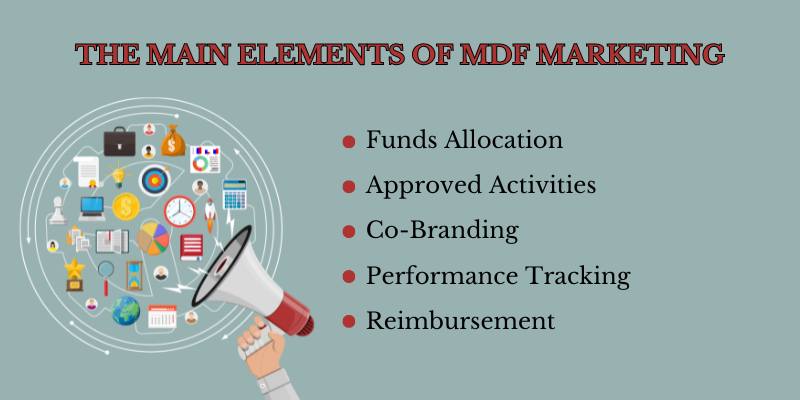So, what are market development funds? MDFs are money given by manufacturers or suppliers to partners.
This article explains Market Development Funds, how they support marketing, their key features, how they differ from Cooperative Funds, and their benefits.
Key Takeaways
- Market Development Funds (MDFs) are financial resources provided by manufacturers to help partners promote products, increasing sales and visibility.
- Manufacturers have control and flexibility, funding co-branded campaigns and retail promotions.
- These funds allow quick changes to marketing strategies as the market shifts.
- MDFs are key to successful partnerships and achieving common marketing goals.
The Main Elements of MDF Marketing

- Funds Allocation: Vendors allocate a specific amount of money to their channel partners, either fixed or performance-based, specifically for marketing activities.
- Approved Activities: Partners must use the funds for pre-approved initiatives such as advertising, events, trade shows, digital campaigns, content creation, and other promotional efforts.
- Co-Branding: MDF campaigns often involve co-branding, where both the partner’s and vendor’s logos, messaging, and products are featured to promote mutual brand visibility.
- Performance Tracking: These programs require detailed reporting. Partners need to show evidence (e.g., receipts, marketing materials) of how they spent the funds and the results they achieved (e.g., leads, sales).
- Reimbursement: After completing the marketing activities, channel partners can claim reimbursement, provided they comply with the vendor’s guidelines.
Examples of Marketing MDF
Here are simple examples of how MDF funds can be used:
Co-branded Advertising Campaigns
Partners team up with manufacturers to run joint advertising campaigns. Ads could showcase both logos, blending brand power. This partnership strategy boosts recognition for manufacturers and allies alike.
MDF funds fuel eye-catching retail displays and in-store promotions
Such investments draw in customers, improve product visibility, and elevate sales at the point of purchase. Consider utilizing product demonstrations, time-sensitive discounts, or themed displays to effectively engage shoppers.
Training Initiatives for Sales Personnel
Manufacturers can train their partner sales teams. This guarantees a comprehensive understanding of the products, enabling them to effectively share product features and benefits with customers.
Participation in Trade Shows and Events
MDF funds can cover the costs of attending trade shows and events, where partners can showcase their products to potential customers. These could include booth rental, promotional materials, travel costs, and more.
Difference Between Market Development Funds and Cooperative
| Aspect | Market Development Funds (MDF) | Cooperative Funds |
| Funding | Fully funded by the manufacturer. | Costs are shared between manufacturer and partner. |
| Control | Manufacturer has full control. | Control is shared between both parties. |
| Cost Responsibility | Manufacturer covers 100% of the costs. | Costs are split between the manufacturer and partner. |
| Flexibility | High flexibility—manufacturer can quickly adjust strategies. | Less flexibility due to joint decision-making. |
| Decision-making | The manufacturer makes all the decisions. | Decisions are made together. |
| Goal Alignment | Manufacturer focuses on their specific goals | Both parties work together towards common goals. |
| Adaptability | Manufacturer can quickly adapt to market changes. | Adaptation is slower due to shared control. |
Benefits of MDF
- Manufacturers have full control over how MDF funds are spent, aligning marketing efforts with their goals.
- These funds allow for quick changes to campaigns, helping businesses respond faster to market shifts.
- MDFs promote creativity and flexibility in marketing strategies.
- They improve product visibility, increase sales, and strengthen partnerships between manufacturers and their partners.
MDF Strategy for Brands: Increasing Brand Visibility
Manufacturers use Market Development Funds to increase their brand awareness in the market.
Purpose?
Not only to get more people to choose their products but also to stay ahead of the competition.
How?
By working with partners and promoting their joint marketing efforts.
When brands collaborate effectively, they don’t just sell – they captivate consumers, create memorable experiences, and build lasting relationships. This strategy puts them ahead of the competition and helps them secure a permanent place in the hearts and minds of their customers.
Collaboration: the Success of MDF
The success of MDFs relies on strong teamwork between the company and its partners. Here’s what that looks like:
- Open Communication: Staying in regular contact is necessary. Clear, open discussions help everyone stay on the same page, building trust and aligning goals. Regular check-ins keep teams connected and focused on what matters.
- Shared Goals: Working together to set common, measurable goals ensures everyone is moving in the same direction. By collaborating on decisions and strategies, both sides can make the most of MDF funds and achieve better results.
Strategic Planning: Making the Most of MDF Funds
Once we’re working together, we need to plan carefully. This helps maximize the use of MDF funds:
Market Research
Understand the market, find opportunities, target the right customers, and study competitors. This helps create strong campaigns that reach the right audience. Additionally, learning about freelance digital marketing could provide more strategies for effective promotion.
Clear Campaigns
Focus each campaign on specific goals, like increasing brand awareness, generating leads, or driving sales. Clear goals lead to better results and faster growth.

Smart Budgeting
Use MDF funds wisely by prioritizing campaigns that offer the best return on investment. Consider the audience, reach, and impact to get the most out of your budget.
Tracking and Measuring Success: Ensuring Accountability
We must monitor MDF campaign performance. This ensures accountability and allows for informed adjustments.
- Establish Key Performance Indicators (KPIs). Define relevant KPIs that align with the set goals. Metrics like website traffic, lead conversion rates, and sales figures show campaign effectiveness.
- Regular Performance Reviews. Conduct regular performance reviews to evaluate campaign progress against KPIs. Identify areas for improvement and make adjustments as needed.
- Performance review insights steer MDF allocation and campaign planning. This data-driven approach optimizes resource use, boosting outcomes. Analyzing past results leads to smart decisions, ensuring future marketing efforts hit the mark.
Final Thoughts Market Development Funds
Market Development Funds are financial resources manufacturers or suppliers provide to their partners to support marketing efforts. These funds are essential for boosting sales and increasing product visibility.
You can use MDF funds in various ways, such as running co-branded advertising campaigns, setting up retail displays, organizing training initiatives, and participating in trade shows.
FAQs on MDF Funds
What are Market Development Funds❓
MDFs are money provided by manufacturers or suppliers to help their partners with marketing. These funds aim to increase sales and improve product visibility.
How do companies use MDFs in marketing❓
MDFs can fund various marketing activities, like joint advertising campaigns, creating in-store displays, training sales teams, and participating in trade shows.
What’s the difference between MDF and Cooperative Funds❓
The manufacturer fully pays for it, giving them control over how the money is spent. Cooperative Funds involve both the manufacturer and the partner sharing the costs of marketing.
What are some examples of how MDF can be used❓
MDF can fund joint ads, retail displays, sales team training, and trade show expenses.
Why are MDFs important for manufacturers❓
MDFs help manufacturers support their partners in marketing their products, increasing brand visibility and sales. They also allow quick marketing strategy changes to adapt to market needs.
